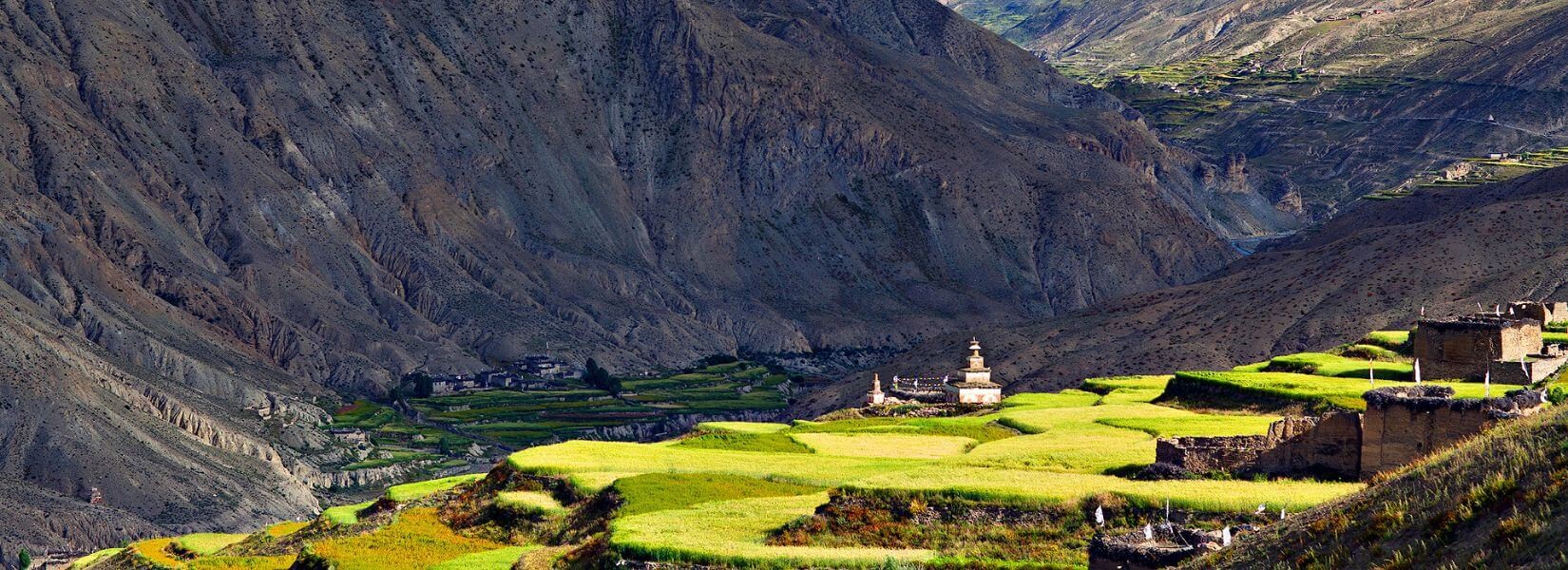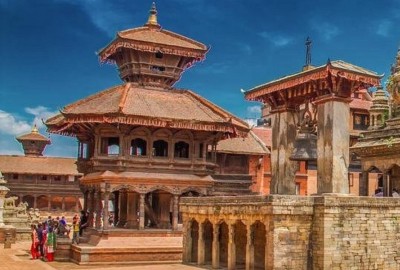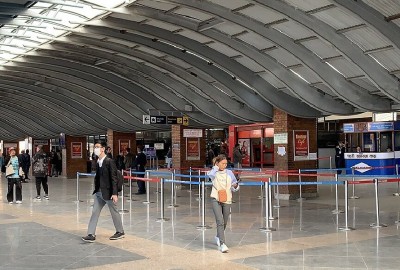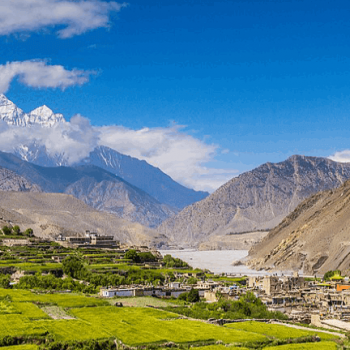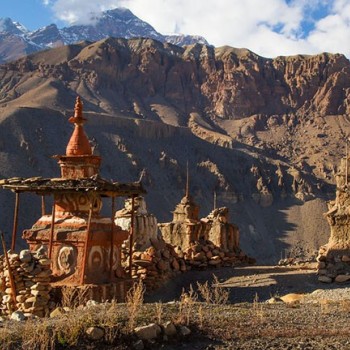Altitude is one of the main challenges of the Upper Dolpo trek, with most of the trek taking place at high altitudes ranging from 3,000 to 5,000 meters above sea level. The trek requires good physical fitness and acclimatization to high altitude, as the air becomes increasingly thin and the body needs to adjust to the lack of oxygen. It is important to take the necessary precautions and to be aware of the signs of altitude sickness, such as headache, fatigue, dizziness, and nausea.
The Upper Dolpo Circuit trekking starts in the town of Juphal, which is located at an altitude of 2,475 meters above sea level. The first few days of the trek involve gradually ascending to the high-altitude regions, with the trail following a gradual incline through the lush forests and rolling hills. This allows trekkers to gradually acclimatize to the high altitude, reducing the risk of altitude sickness.
One of the highlights of the Upper Dolpo trek is the stunning views of the Dhaulagiri and Annapurna mountain ranges, which can be seen from various points along the trail. The trek also offers a chance to explore the ancient cultural heritage of the Dolpo region, with many villages and monasteries dotted along the way.
As the trek continues, the trail becomes steeper and the air becomes increasingly thin, with many of the trek's highest passes located above 4,000 meters above sea level. Some of the most challenging parts of the trek include the Numa La pass, which is located at an altitude of 5,190 meters above sea level, and the Baga La pass, which is located at an altitude of 5,090 meters above sea level. These passes offer stunning views of the surrounding landscape, but they also require a good level of fitness and acclimatization to high altitudes.
Along the way, trekkers will have the opportunity to explore the many pristine lakes and streams that are found in the Dolpo region, including the stunning Phoksundo Lake, which is one of the largest and most beautiful high-altitude lakes in Nepal. The lake is surrounded by a lush forest and towering peaks, making it a truly breathtaking sight.
The Upper Dolpo trek ends in the village of Dunai, which is located at an altitude of 2,850 meters above sea level. From here, trekkers can return to Juphal by taking a flight or a jeep, depending on the availability of transportation.
How to acclimatize to the Altitude of the Upper Dolpo Trek: Essential Tips and Advice
One of the key features of the trek is the high altitude, which requires good physical fitness and acclimatization to ensure a safe and enjoyable experience. In this article, we'll take a closer look at how to acclimatize to the altitude of the Upper Dolpo trek, with tips and advice to help you prepare for the journey ahead.
Gradual ascent
The first and most important factor in acclimatizing to high altitude is to allow for a gradual ascent. This means taking your time and allowing your body to adjust to the thinning air and reduced oxygen levels, rather than pushing yourself too hard and risking altitude sickness. The Upper Dolpo trek follows a gradual incline, taking trekkers from the starting altitude of 2,475 meters to the highest point at the Numa La pass, which is located at an altitude of 5,190 meters. This gradual ascent allows trekkers to acclimatize to the altitude and reduces the risk of altitude sickness.
Hydration
Staying hydrated is essential when trekking at high altitudes, as the body loses more water through breathing and sweating. It's important to drink plenty of water and avoid alcohol and caffeine, which can dehydrate the body. Aim to drink at least 3-4 liters of water per day, and carry a water bottle with you at all times.
Rest and sleep
Give your body the rest it needs by taking regular breaks and avoiding overexertion. Sleeping at high altitudes can also be challenging, as the body works harder to adjust to the reduced oxygen levels. It's important to get plenty of rest, take regular naps, and ensure that you get a good night's sleep.
Eating a balanced diet
Eating a balanced diet is important for maintaining energy levels and staying healthy during the trek. Aim to eat a diet that is rich in carbohydrates, proteins, and healthy fats, and avoid overeating, as this can put additional strain on the body.
Altitude sickness medication
In some cases, altitude sickness medication may be necessary to help prevent or treat the symptoms of altitude sickness. Consult with your doctor or a medical professional before starting the trek, and carry a first aid kit with you at all times, including any necessary medication.
Acclimatization hikes
Taking acclimatization hikes is another effective way to acclimatize to the altitude of the Upper Dolpo trek. This involves taking short hikes at higher altitudes, allowing the body to gradually adjust to the thinner air. Acclimatization hikes are particularly important for those who are not used to trekking at high altitudes, or for those who have a history of altitude sickness.
Listen to your body
Finally, it's important to listen to your body and take the necessary precautions to avoid altitude sickness. If you experience any symptoms of altitude sickness, such as headache, fatigue, dizziness, or nausea, it's important to descend to a lower altitude and seek medical attention if necessary.
Acclimatizing to the altitude of the Upper Dolpo trek requires a combination of good physical fitness, careful planning, and a gradual ascent. By following the tips and advice outlined in this article, you can prepare yourself for the journey ahead and ensure a safe and enjoyable experience in the stunning mountain landscapes of Nepal.
How to Prepare Yourself?
To ensure that you are fully prepared for the journey ahead, it's important to consider several physical, mental, and logistical factors. In this article, we'll take a closer look at how to prepare yourself for the Upper Dolpo trek, with tips and advice to help you get ready for the adventure of a lifetime.
Physical preparation
The Upper Dolpo trek is a physically demanding journey, requiring good levels of fitness and endurance. To prepare yourself, it's important to engage in regular exercises and physical activity, such as running, hiking, or cycling. This will help you to build up your endurance, strength, and flexibility, as well as give you a taste of the challenges that you'll face during the trek.
Mental preparation
The Upper Dolpo trek can be a mentally challenging experience, as trekkers face a range of environmental, physical, and emotional challenges. To prepare yourself mentally, it's important to practice mindfulness and relaxation techniques, such as meditation, yoga, or deep breathing exercises. This will help you to stay calm, focused, and positive during the trek, even when faced with challenging situations.
Logistical preparation
Logistical preparation is also an important factor in preparing yourself for the Upper Dolpo trek. This involves ensuring that you have all the necessary gear, equipment, and supplies that you need for the journey ahead. This might include items such as warm clothing, a good-quality backpack, a sleeping bag, a water bottle, and a first aid kit, among others. Make sure that you have all the gear that you need before setting off on the trek.
Acclimatization
Acclimatizing to the altitude of the Upper Dolpo trek is an important factor in ensuring a safe and enjoyable experience. To acclimatize, it's important to follow a gradual ascent, stay hydrated, get plenty of rest and sleep, and eat a balanced diet. You may also need to take altitude sickness medication and consider taking acclimatization hikes to help your body adjust to the thinner air.
Health and safety
Health and safety are always a priority when trekking in the mountains. To prepare yourself, it's important to have comprehensive travel and medical insurance, to carry a first aid kit with you at all times, and to seek medical advice if necessary. It's also important to be aware of the potential risks associated with high-altitude trekking, such as altitude sickness, and to take the necessary precautions to minimize these risks.
Research and planning
Researching and planning the Upper Dolpo trek is also an important part of preparing yourself for the journey ahead. This involves reading up on the trek, the local culture, the weather conditions, and the best time to visit. It's also important to plan your route, consider the cost of the trek, and book your trekking permit and any necessary equipment in advance.
Conclusion
Upper Dolpo trek is a high-altitude adventure in Nepal, offering a unique and challenging trekking experience through remote and rugged terrain. The trek requires good physical fitness and acclimatization to high altitude and careful consideration of the potential effects of altitude sickness. Despite the challenges, the trek offers an incredible opportunity to explore some of the most stunning mountain landscapes in Nepal and to experience the rich cultural heritage of the Dolpo region.

